by Robert Fedderson | Feb 20, 2019 | Guide, Prospect Research, Relationship Mapping
Sometimes prospect research is about looking at list of names and determining propensity, affinity and capacity. This is typically how things work at larger organizations. A near endless stream of names pouring in due to brand recognition, marketing campaigns, event attendee lists, and alumni and patient databases, means that some prospect researchers are never without a name to work on.
For prospect researchers without that level of inbound traffic, early funnel research is an essential part of the prospect research process. After all, you can’t qualify or disqualify prospects you don’t have yet.
In this guide, we will discuss early funnel prospect research and show you how to find new names you can convert into donors.
Donation Records
Searching donation records is the best place to find early funnel prospects. Full stop. Donation records tell you three extremely valuable things:
- The causes and organizations the prospect gives to
- The dollar ranges the prospect gives in
- The geographic location the prospect gives in
A prospect is well on the way be being qualified if he or she is:
- Giving to organizations with missions similar to yours
- Giving in dollar ranges that meet your objectives
- Giving in the geographic area your organization positively impacts
Location
Proximity based prospect research mainly relies on a single assumption: If my prospect lives in the area my organization positively impacts, he or she is more likely to make a gift than some who does not live in the area my organization positively impacts.
Follow the link for more on proximity based prospect research.
Biography
Reviewing biographies (especially if they are electronic and searchable) is a fantastic place to find early funnel prospects for two reasons. One, people who have biographies tend to be wealthy, influential, or both. This is especially true of biographies found in collections such as Canadian Who’s Who. Two, a biography can give you useful information that will help you qualify or disqualify the prospect.
The following questions are instructive when searching and reading biographies:
- Was the person born in the city or town my organization is active in?
- Does my organization have a strong group of supporters that attended that same school as the person? Is there anything about this person’s education history that connects him or her to my organization?
- Does this person currently live in the same city my organization is active in?
- Is there anything about this person’s career highlights that suggest a possible connection with my organization? Keep an eye out for phrases that indicate the person championed certain causes at his or her organization. If your mission ties into those causes you could be well on your way to finding a new prospect.
- Is there anything about this person’s personal life that suggests a possible connection with my organization? Phrases such as “lifelong interest in the arts” and “strong commitment to at risk youth” are what you want to look for here.
Connections
Mining your organization’s connections is an extremely effective way to find early funnel prospect. Almost all boards have a fundraising mandate, even if it isn’t explicit. Talk to your board members. Ask them about their personal and professional networks. Relationship mapping is a fantastic way to both mine and visualize those connections. Follow the links below for more on relationship mapping:
- Relationship Maps
- Relationship Paths
by Robert Fedderson | Jan 25, 2019 | Features, Guide, Prospect Research, Relationship Mapping
The ability to set a default organization is a new feature in CharityCAN that impacts both the prospect profile builder and relationship path searches. In this short guide, you will learn how to set a default organization and a few ways it can help you use CharityCAN more effectively.
How do I set a default organization?
There are two ways to set a default organization:
- Go to My Prospect Profiles and on the right side of the screen select Select Default Organization. Type in the name of any registered charity or profiled corporation to set it as your default organization. You will notice a list of suggested prospects will populate. Cool and super interesting right? I agree. More on this later.
- Go to Relationship Paths and type in the name of any registered charity or profiled corporation to set it as your default organization.
Okay, I’ve set a default organization. Now what?
Suggested Prospect Profiles
Now that you’ve set a default organization you will notice My Prospect Profiles looks a little different. Setting a default organization allows CharityCAN to suggest potentially interesting prospect profiles to you based on the strength of the connection to your default organization. If you are looking for new people to add to your pipeline, setting your organization as the default organization and looking through the profiles CharityCAN pushes to you is an awesome place to start.
Alternatively, you could set a granting foundation or corporate sponsor who has been a major friend to your organization as the default organization. CharityCAN will then suggest a list of profile with connections to the granting foundation or corporate sponsor.
Easier Relationship Path Searches
Once an organization has been set as the default organization it will auto-populate in the from section of all relationship path searches.
If you would like more information on this or have any questions please email us at info@charitycan.ca
by Robert Fedderson | Jan 2, 2019 | Features, Prospect Research, Relationship Mapping
Although the majority of giving in Canada is done by individual donors, charitable foundations are an important source of funding all Canadian fundraising organizations should consider. In this guide, you will learn how to use CharityCAN to effectively research, qualify, and connect with charitable foundations.
Research
First, we need to qualify a foundation as a prospect. If you are looking for a brand-new donor, head over to donation records and search for a foundation that has given to your cause in the past, in a dollar range that fits your parameters. If you already know the name of the foundation you would like to research, go to Integrated Search and select the Organization tab. Entering the name of the foundation in this search field, will return all of the information CharityCAN has on the foundation. From here, you can take a quick look at donation records and ZoomInfo contact information. For comprehensive research, however, we need to open their detailed Charity Report.

Qualify
The detailed Charity Report lets us review financials to make sure the prospect is in good shape to make a gift; the people on the board of directors so we can understand who the decision makers are; and, most importantly, their entire giving history. There is often a disconnect in the causes a foundation claims to fund in its stated purpose and the causes it funds. For this reason, reviewing giving history as opposed to simply reading a stated purpose or description is critical to successful foundation research.
The default view under Gifts returns all gifts the foundation has ever made. You can also use the drop down to view specific years. When reviewing gifts look at the size of the gifts, the categories they give to, and location of the gift recipients. If the foundation is giving in dollar ranges that make sense for you to pursue and to organizations with broadly similar missions to yours, they are well on their way to being a well-qualified prospect.
CharityCAN’s interactive gift visualization charts are useful at this stage. The charts quickly show the proportion of gifts going to certain causes and locations. You can also use CharityCAN’s gift visualization charts to drill down even further and determine the total dollar value of gifts to a specific cause, specific location or a specific cause in a specific location.
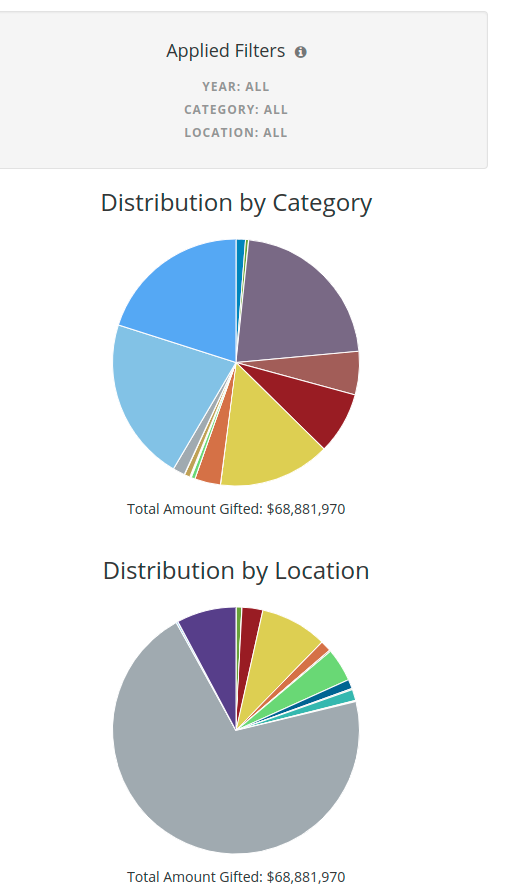
It is worth noting that foundation giving histories can be exported to excel and stored on your local donor management system. CharityCAN does not cap or restrict data exports and almost all data in CharityCAN can be exported.
Connect
After qualifying a foundation as legitimate prospect, use the Relationship Paths tool to see if your board has any connections to the foundation you can utilize in your approach. Relationship Paths searches our entire Relationship Graph to see if your board has connections to the board of the organization you are researching. In the search displayed below, I found 24 connections the Special Olympics Canada board has to the MLSE Foundation board.
When doing a Relationship Path search, it is worthwhile to look some of the other organizations you are connected to. In addition to the MLSE connection, this search also revealed connections to Tim Hortons, Tim Hortons Children’s Charities, The Justin Eves Foundation and RioCan.
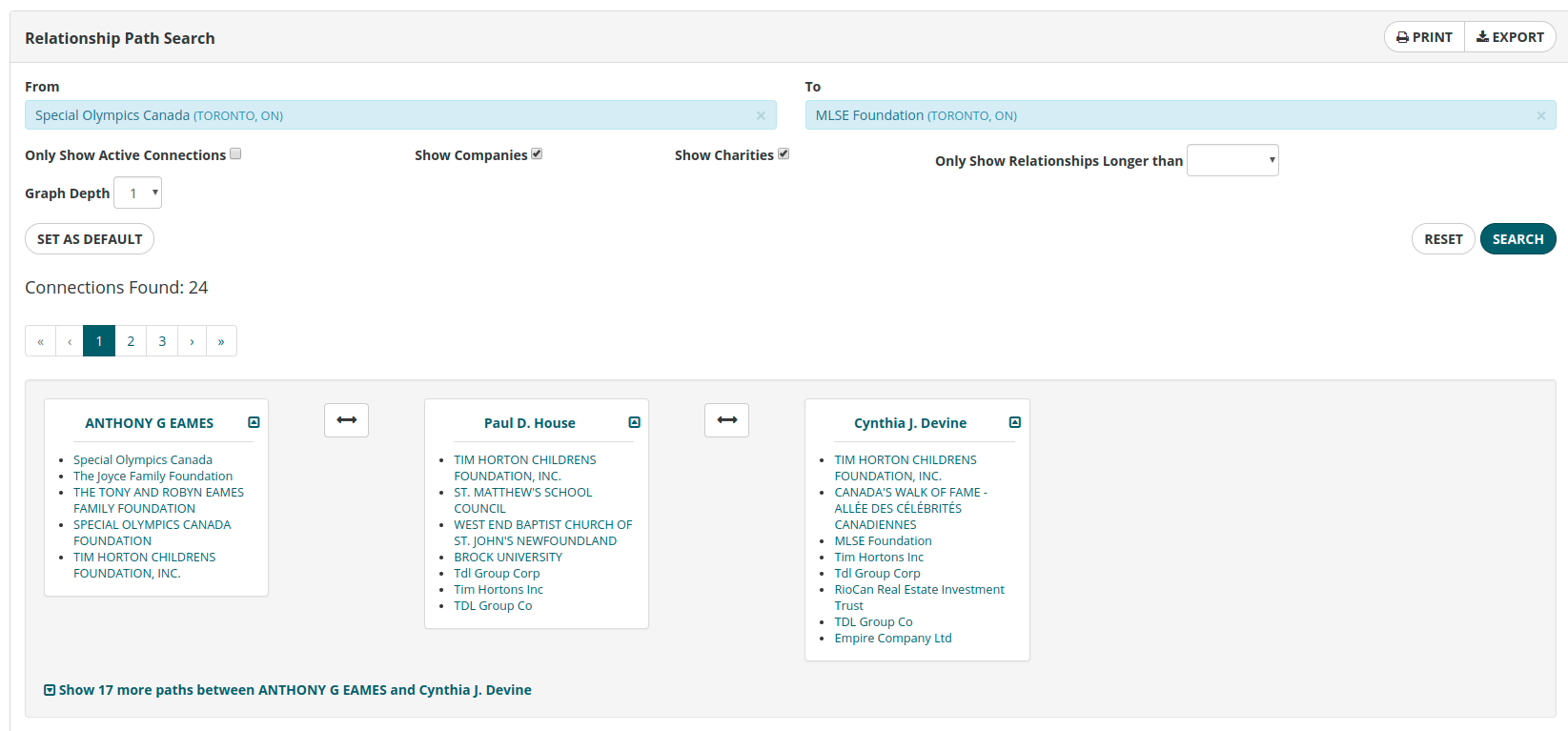
CharityCAN’s foundation research tools give you the information you need to fundraise more effectively from Canadian granting foundations. Remember: use donation records to identify a new prospect, use the Integrated Search and the Analyst Report to qualify your prospect and then use Relationship Paths to search for connections you have to your prospect!
If you have any questions or would like to set up a quick demo of any of the features discussed, please do not hesitate to email us at info@charitycan.ca!
by Matt Charters | Oct 4, 2018 | Features, Guide, Relationship Mapping
Today we’re announcing that we’ve supercharged the engine that powers our relationship mapping features. A lot of those changes have happened under the hood here at CharityCAN, and aren’t immediately apparent. While you can’t see some of the differences to the platform yet, we’re also announcing the first of the new features that this new engine enables: the ability to modify a saved profile’s relationship map by adding or removing charity and corporate board positions.
On saved profiles that currently have charity boards listed, you can add and remove board positions by hovering over the position you’re interested in: On saved profiles without current board positions, you can now add different profile sections – corporate and charity board positions, as well as a FullContact social media summary:
On saved profiles without current board positions, you can now add different profile sections – corporate and charity board positions, as well as a FullContact social media summary: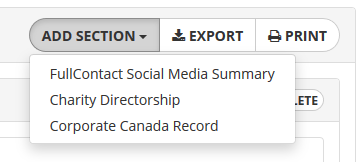 Since our relationship maps are built on these charity and corporate board connections, as you add and remove board positions, you’ll see the saved profile’s relationship map update in real time.
Since our relationship maps are built on these charity and corporate board connections, as you add and remove board positions, you’ll see the saved profile’s relationship map update in real time.
The best part about this new relationship graph engine is all the new possibilities that it opens up. We’ve got a few more features that use the new engine in the pipeline that we’re excited to share with you soon! If you have an idea about how you’d like to use our relationship map data, please let us know!
by Robert Fedderson | Jun 15, 2018 | Prospect Research, Relationship Mapping
The proximity principle suggests we form our strongest relationships with people close to us. This is fairly intuitive. Most of us would point to the people close to us – family, friends, neighbours, colleagues – as the strongest relationships in our lives. These relationships can be very influential. The way we think and act is strongly influenced by the people close to us. Our behaviour is, to a certain extent, dictated by the people around us.
Why is this relevant to a fundraising organization?
Fundraising organizations can leverage the proximity principle by looking at the people close to their donors. A major gift donor’s family, friends, neighbours and colleagues are influenced by the major gift donor and vice versa. They are close to each to other and they have formed strong, influential relationships.
How can we find people in close proximity to our donors?
Colleagues
In Canada, many major gift donors give both time and money to charities. They sit on charity boards and, in many cases, corporate boards. Realizing these connections is a powerful fundraising tool. Look at the boards your major gift donors sit on and then look at the other people on those boards. They have a relationship with your major gift donor and are likely influenced by your major gift donor. There is a good chance these people can become your next major donor.
Let’s take a look at some of the board connections of one of Canada’s most generous philanthropists, Gerald Schwartz. Note: this list includes historical and current board memberships.
Charity Boards:
- Sinai Health System
- Mount Sinai Hospital Employees’ Charity Trust
- Friends of Simon Wiesenthal Center for Holocaust Studies
- The Gerald Schwartz and Heather Reisman Foundation
- The TVOntario Foundation
- Canadian Society for Yad Vashem
- Heseg Foundation
Corporate Boards
- Indigo Books & Music Inc
- ONEX Corporation
- Bank of Nova Scotia
- Celestica Inc
- Constellation Brands Canada Inc
- Loews Cineplex Entertainment Corp
- Scotia Mortgage Investment Corporation
Judging by these positions, Gerald Schwartz is connected to a number of people who will be of interest to a fundraising organization. Mapping these relationships will allow us to see who Mr. Schwartz is in closest “proximity” to and allow us to see if those connections are worth looking into further.
I generated this map using CharityCAN’s relationship map function and CRA and Corporate Canada data. Alternatively, this could be done by pulling CRA data and relevant management proxy circulars and manually creating a relationship map.
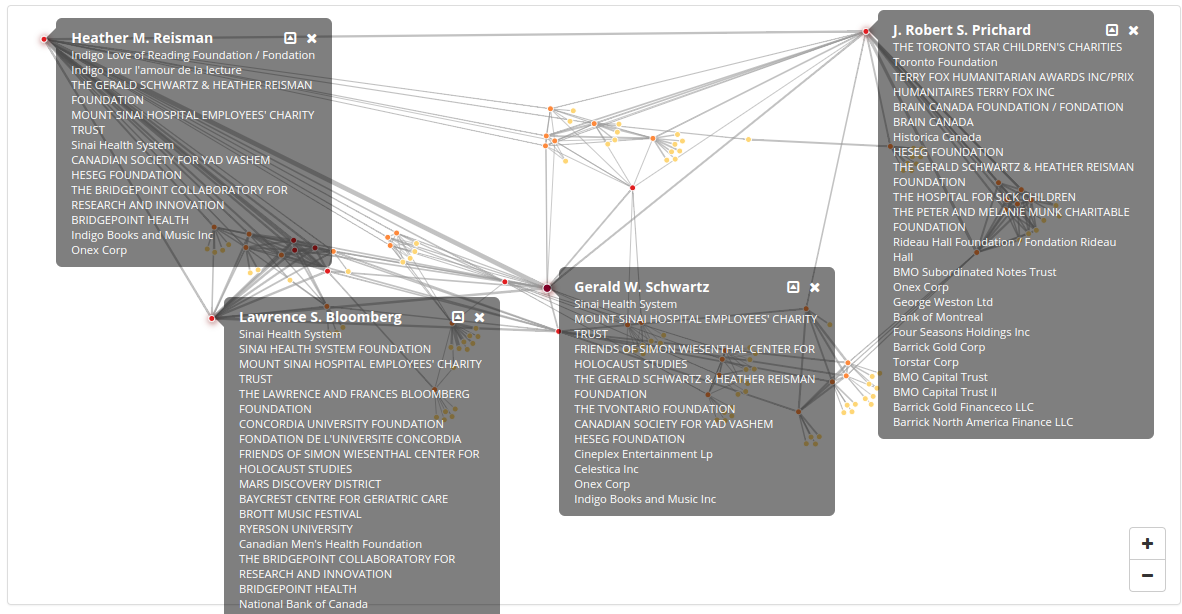
As we can see from this relationship map, there are a number of people in proximity to Gerald Schwartz who are plausible major gift prospects. This example illustrates how fruitful understanding who is in proximity to your major donors, board members, or any other friend of your organization can be.
Neighbours
Another way fundraisers can use proximity to find new prospects is by examining who lives close to their major donors. Postal code analysis is the easiest way to do this. Simply cross reference a new prospect’s postal code against your donor database and see if your prospect lives in the same neighbourhood as any of your major donors. This can be a valuable indicator of proximity influence as well a useful conversation starter.
CharityCAN’s postal code lookup tool can do this quickly, as well as show you important wealth indicators such as average dwelling value, discretionary income, and donations for that postal code. In the example below, I did a lookup on the postal code of a fictional major donor. In addition to the wealth indicators, this search shows me three other potential donors who live in the same neighbourhood as my major donor.
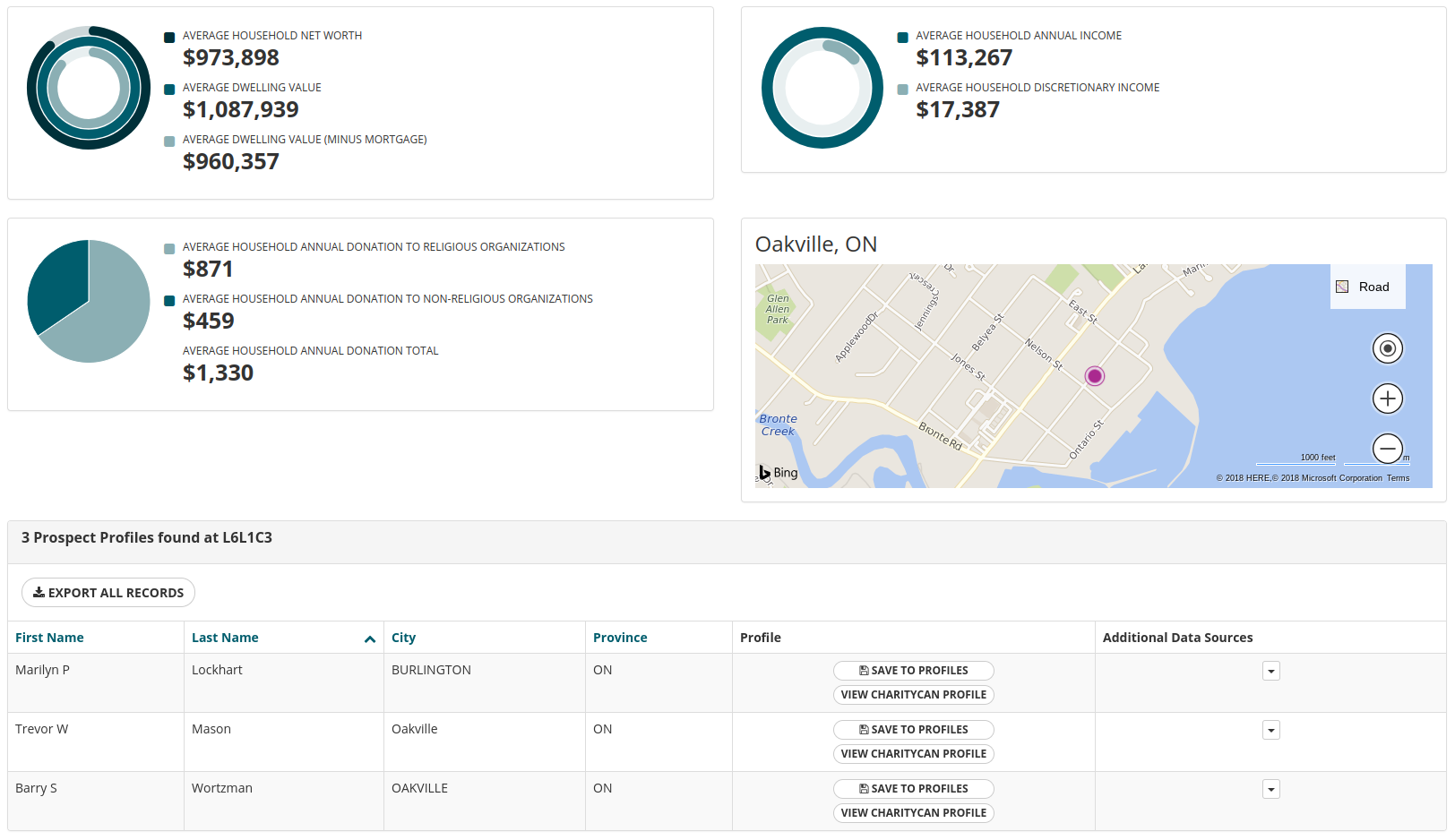
The above examples make a strong case that proximity research is prospect research time well spent. Looking at who is in proximity to our major gift donors can quickly generate a list of prospects worthy of further research. Finding out who your donors colleagues and neighbours are can be the first step to finding your next major gift donor.
by Robert Fedderson | Apr 24, 2018 | Guide, Prospect Research, Relationship Mapping
Prospect research is necessary for fundraising organizations of all sizes. Identifying, understanding, and connecting with potential donors – whether they are individuals, granting foundations, or corporations – is critical to the success of modern charities and non-profits. Fundraising without prospect research is like travelling without directions. If you do get to your destination, your trip was certainly more difficult than it had to be. Fundraising without prospect research consumes unnecessary resources, is less predictable, and perhaps most importantly, brings in fewer dollars.
Successful prospect research means being able to answer the following questions about your prospective donors as efficiently and accurately as possible:
- Do they engage in philanthropy?
- What are their philanthropic focus areas?
- Do they have the ability to make a gift that fits the goals of my organization?
- Does my organization have a connection to them we can use to create a meaningful relationship?
In this guide, we will introduce you to the fundamental elements of prospect research by looking at propensity, capacity, affinity, and connection.
Propensity
Propensity is the inclination or tendency to behave a certain way. As it relates to prospect research and fundraising, it refers to the inclination or tendency to make donations to charitable causes and organizations. Simply put, if someone has never given a charitable gift their propensity to make charitable donations is a quite low, whereas if someone is a monthly donor to a variety of causes their propensity to make charitable donations is quite high.
The easiest way to quickly gauge propensity is by examining donation history. This is best accomplished by examining internal donation records so you have a sense of how often the prospect gives to your organization and external donation records so you have a sense of how often the prospect gives to other organizations.
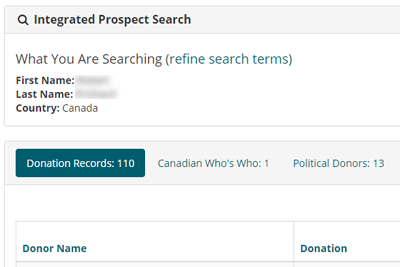
Another useful way to gauge propensity is by looking at how your prospect spends his or her time. This method is less useful with corporate or granting foundation prospects, but can be invaluable when assessing an individual’s propensity. The following questions are instructive:
- Has my prospect spent any time on the board of a charity or a non-profit?
- Is my prospect politically active?
- Is my prospect active in the community?
These questions will help determine if your prospect has the inclination to donate a valuable a resource – time – to pursuits beyond self-interest. Public service can be a powerful indicator of how an individual views his or her role in society and his or her propensity for charitable engagement.
Affinity
Affinity is best described as fondness or liking. In fundraising, affinity can be understood as a fondness for your mission or organization. If 100% of a foundation’s grants have been awarded to organizations supporting animal welfare, that foundation has a strong affinity for organizations that support animal welfare. As with propensity, donation records are great way to begin to gauge affinity.
When considering affinity, it is important to understand the difference between mission and organization. Consider the following: an individual has a donation history that is comprised entirely of gifts to her alma mater. Does this individual have an affinity for education as a cause or mission or an affinity for this specific institution? It is probably inaccurate to say she has an affinity for post-secondary education as a cause, it is far more likely she has an affinity for the place she went to school.
Capacity
In fundraising, capacity refers to a prospect’s ability to give. Typically, capacity is measured by wealth. The wealthier a prospect, the greater the capacity to give. When looking at an individual donor, prospect researchers examine things like compensation, real estate holdings and other assets (and liabilities if possible) to determine capacity. For granting foundations, prospect researchers will look at revenue and expenses and assets and liabilities. Corporations get a little trickier, especially if private, but yearly revenue, cash, and assets and liabilities are all ways prospect researchers will determine capacity.
A major challenge prospect researchers face when determining capacity is total wealth. Unless you have access to a prospect’s entire financial history or he tells you (and you have reason to believe him), it is almost impossible to determine exact wealth.
Consider the following scenario. You are researching two prospective donors and have access to the reasonably accurate information about the market value of their homes. Prospect A owns a home with a market value of $2 million. Prospect B owns a home with a market value of $500,000. Simple enough, right? Prospect A has a greater capacity to give than prospect B. But what if prospect A has a mortgage of $1.7 million remaining on the home and prospect B paid for the home in cash and doesn’t carry a mortgage? Some of back of the napkin math shows that dwelling value minus mortgage for prospect A is $300,000 and dwelling value minus mortgage for prospect B is $500,000. Perhaps prospect B has the greater capacity after all. What if you also have compensation data for both prospects and last year prospect A received a total compensation package (salary, bonus, stock) from her employer of $600,000 and prospect B received a salary of $120,000? It looks like prospect A is back in the lead.
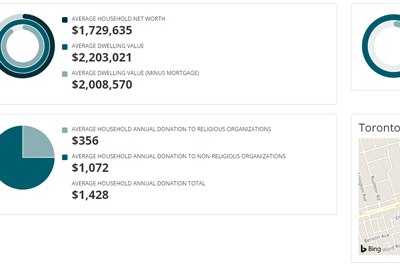
This example helps illustrate the primary challenges prospect researchers face when determining capacity: availability of information. Data on the market value of the properties is one piece of information that will likely paint an inaccurate portrait of the prospects’ capacity. Data on the market value of the properties plus mortgage liabilities gives us two pieces of information and our portrait starts to get more accurate. Data on property values, mortgage liabilities and compensation gives us three pieces of information and, probably, a reasonably accurate portrait of both prospects’ capacity to give.
Connections
Traditionally, prospect research has focused strictly on determining propensity, affinity and capacity and supplying research and data that supports those determinations. Connecting with potential donors has been left to fundraisers. This is changing. Data that reveals organizational connections and relationships is becoming more readily available. This is helping to make relationships and connections more quantifiable than they have ever been. Compare “a member of our board served on the board of a company we would like to approach for a sponsorship from 2009-2015” versus “I’m pretty sure they used to golf together.” The availability of objective data about connections is pushing relationship research under the purview of prospect researchers.
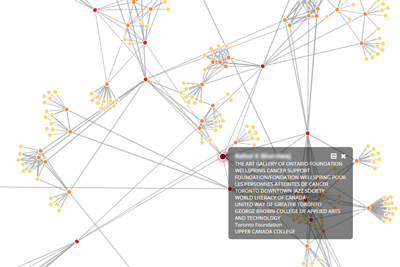
When researching relationships, your most important concern should be verifiable data. Treat relationship data like you would donation or compensation data and look for the best data available. T3010 data (the T3010 is the tax form required by the Canada Revenue Agency to be filed yearly by every registered charity and lists the individuals on the charity’s board of directors) and management proxy circulars (securities regulators require publicly traded companies to file circulars that list key officers, executives and board of directors members) are a great place to start researching connections and relationships. Both are legal documents listing the key people at the organizations; analyzing them can help you determine – from a wholly verifiable source – who knows who and how they are connected.
A very fruitful place to start looking for connections is your own board of directors. Almost all board members have – at the very least – an implicit fundraising mandate. Also, many board members serve on multiple boards, both charity and corporate. Mining the connections of your board of directors for relationships with people who sit on the boards of large companies or granting foundations can be the difference between an accepted sponsorship, gift or grant request and a rejected one.
Conclusion
Imagine you are tasked to create a list of donors with the potential of making a $10,000 gift to your organization. First, you need to determine propensity. You can do this by examining your list of prospects eliminating those that have never made a charitable gift. Second, you need to determine affinity. To do this, eliminate the names on the list who only give to organizations with dissimilar missions or have a well documented history of only giving to a single organization. Third, you need to determine capacity. To do this, use real estate, financial holdings, and compensation data to eliminate the names on the list who do not have the capacity to make a $10,000 gift. The names left on your list are reasonably well-qualified prospects to make a $10,000 gift to your organization. Finally, research connections and relationships to determine if your organization is linked in any way to the remaining names. The names you do have connections with should be prioritized for approach. They have the propensity to give, an affinity for your cause, the capacity to make a gift you are pursuing, and connections to your organization you can utilize in your approach. They are well-qualified prospects.
Understanding the fundamental aspects of prospect research will help you direct your research more efficiently. You will spend less time chasing down information of questionable value and more time finding verifiable data that helps answer the necessary questions about propensity, affinity, capacity, and connection.



 On saved profiles without current board positions, you can now add different profile sections – corporate and charity board positions, as well as a FullContact social media summary:
On saved profiles without current board positions, you can now add different profile sections – corporate and charity board positions, as well as a FullContact social media summary: Since our relationship maps are built on these charity and corporate board connections, as you add and remove board positions, you’ll see the saved profile’s relationship map update in real time.
Since our relationship maps are built on these charity and corporate board connections, as you add and remove board positions, you’ll see the saved profile’s relationship map update in real time.



